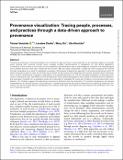Files in this item
Provenance visualization : tracing people, processes, and practices through a data-driven approach to provenance
Item metadata
| dc.contributor.author | Vancisin, Tomas | |
| dc.contributor.author | Clarke, Loraine | |
| dc.contributor.author | Orr, Mary | |
| dc.contributor.author | Hinrichs, Uta | |
| dc.date.accessioned | 2023-05-09T14:30:10Z | |
| dc.date.available | 2023-05-09T14:30:10Z | |
| dc.date.issued | 2023-09-01 | |
| dc.identifier | 285676755 | |
| dc.identifier | 6afaa126-9412-42f1-9ccb-7783bc485f6a | |
| dc.identifier | 85172223405 | |
| dc.identifier.citation | Vancisin , T , Clarke , L , Orr , M & Hinrichs , U 2023 , ' Provenance visualization : tracing people, processes, and practices through a data-driven approach to provenance ' , Digital Scholarship in the Humanities , vol. 38 , no. 3 , fqad020 , pp. 1322-1339 . https://doi.org/10.1093/llc/fqad020 | en |
| dc.identifier.issn | 2055-7671 | |
| dc.identifier.other | Jisc: 1060029 | |
| dc.identifier.other | ORCID: /0000-0001-9213-1013/work/135018758 | |
| dc.identifier.other | ORCID: /0000-0002-3485-5088/work/135018968 | |
| dc.identifier.uri | https://hdl.handle.net/10023/27545 | |
| dc.description | Funding: PhD research was funded by the Alfred Dunhill Links Foundation Postgraduate Scholarship. | en |
| dc.description.abstract | Provenance disclosure—the documentation of an artifact’s origin and how it was produced—is an important aspect to consider when working with historical records which undergo multiple transformations in preparation for and during digitization. Provenance in this context is commonly communicated through explanatory text or static diagrams. However, the methodological and curatorial decisions that have influenced the records’ data are easily overlooked, in particular when exploring the records through visualization as a result of digitization processes. We propose a data-driven approach to provenance disclosure which (1) traces provenance back to when the records were created, (2) documents and categorizes the records’ transformations (transcriptions, content modifications, changes in organization, and representational form), and (3) uses data visualization to disclose provenance in interactive ways. We reflect on how this approach can be practically applied in the context of historical record collections, and we present findings from a qualitative study we conducted to investigate the merits and limitations of provenance-driven visualization. Our findings suggest that data-driven provenance disclosure has the potential to (1) promote transparency and deeper interpretations of historical records, (2) provide rigor in researching historical document collections and underlying production processes, and (3) encourage ethical considerations by making visible labor and implicit bias that influence the production and curation of historical records. | |
| dc.format.extent | 18 | |
| dc.format.extent | 954193 | |
| dc.language.iso | eng | |
| dc.relation.ispartof | Digital Scholarship in the Humanities | en |
| dc.subject | Computer science applications | en |
| dc.subject | Linguistics and language | en |
| dc.subject | Language and linguistics | en |
| dc.subject | Information systems | en |
| dc.subject | QA75 Electronic computers. Computer science | en |
| dc.subject | 3rd-DAS | en |
| dc.subject | AC | en |
| dc.subject | MCC | en |
| dc.subject.lcc | QA75 | en |
| dc.title | Provenance visualization : tracing people, processes, and practices through a data-driven approach to provenance | en |
| dc.type | Journal article | en |
| dc.contributor.institution | University of St Andrews. School of Computer Science | en |
| dc.contributor.institution | University of St Andrews. French | en |
| dc.identifier.doi | https://doi.org/10.1093/llc/fqad020 | |
| dc.description.status | Peer reviewed | en |
This item appears in the following Collection(s)
Items in the St Andrews Research Repository are protected by copyright, with all rights reserved, unless otherwise indicated.

